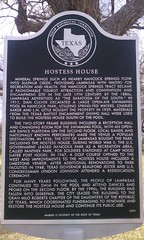Charles Baker
Charles Baker
man
Aged unknown
Commemorated on 1 plaque
Hostess House. Mineral springs such as nearby Hancock Springs flow into Sulphur Creek, providing Lampasas with waters for recreation and health. The Hancock Springs tract became a fashionable tourist attraction and convention and encampment site in the late 19th century; by the 1880s, Lampasas advertised as “The Saratoga of the South.” In 1911, Dan Culver excavated a large open-air swimming pool in Hancock Park, utilizing spring-fed waters. Charles Baker and L. N. Little bought the property in 1929. Materials from the Texas Baptist Encampment dining hall were used to build the Hostess House south of the pool. The two-story frame building included a reception hall and changing room for the swimming pool, with an open-air dance platform on the second floor. Local bands and nationally known performers made the venue a popular destination. In 1936, the city of Lampasas bought the park, including the Hostess House. During World War II, the U.S. government leased Hancock Park as a recreation area, called Panther Park, for soldiers stationed at Camp Hood (later Fort Hood). In 1947, a golf course opened to the west and improvements to the Hostess House included a limestone veneer. After additional renovations to park facilities in 1948, Texas Governor Beauford Jester and U.S. Congressman Lyndon Johnson attended a rededication ceremony. For many years following, the people of Lampasas continued to swim in the pool and attend dances and proms on the second floor. By the 1990s, the building had fallen into disrepair. The city leased the building to the Oran Milo Roberts chapter of the Daughters of the Republic of Texas, which coordinated fundraising to renovate and restore the Hostess House and continue its public use.
1600 South Highway 281, Lampasas, TX, United States where they owned (1929)

